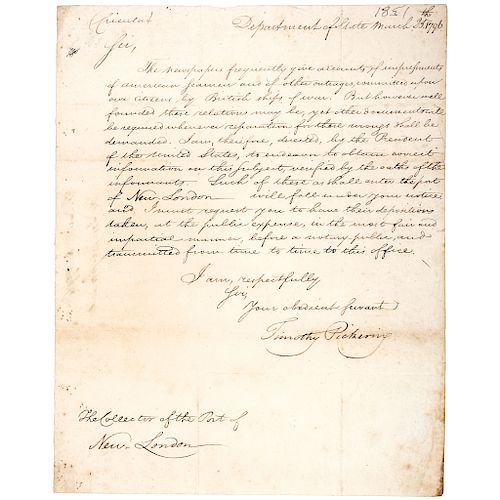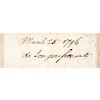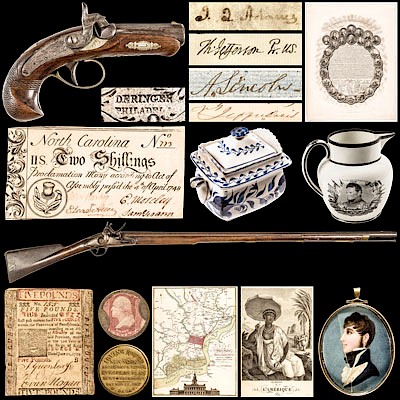1796 American Seamen Impressments, Timothy Pickering ALS U.S. Secretary of State
Lot 80
Categories
Estimate:
$2,400 - $3,400
Absentee vs Live bid
Two ways to bid:
- Leave a max absentee bid and the platform will bid on your behalf up to your maximum bid during the live auction.
- Bid live during the auction and your bids will be submitted real-time to the auctioneer.
Bid Increments
| Price | Bid Increment |
|---|---|
| $0 | $10 |
| $200 | $20 |
| $300 | $25 |
| $500 | $50 |
| $1,000 | $100 |
| $2,000 | $200 |
| $3,000 | $250 |
| $5,000 | $500 |
| $10,000 | $1,000 |
| $20,000 | $2,000 |
| $30,000 | $2,500 |
| $50,000 | $5,000 |
| $100,000 | $10,000 |
| $200,000 | $20,000 |
| $300,000 | $25,000 |
| $500,000 | $50,000 |
About Auction
By Early American History Auctions
Oct 19, 2019
Set Reminder
2019-10-19 12:00:00
2019-10-19 12:00:00
America/New_York
Bidsquare
Bidsquare : Historic Autographs-Currency-Political-Americana-Militaria-Guns
https://www.bidsquare.com/auctions/early-american-history-auctions/historic-autographs-currency-political-americana-militaria-guns-4513
326 Lots of Rare, Historic Autographs, Americana, Civil War Era, George Washington, Abraham Lincoln, Black History, Revolutionary War Era, Colonial America, Federal Period, War of 1812, Colonial Currency, Indian Peace Medals & more... Early American History Auctions auctions@earlyamerican.com
326 Lots of Rare, Historic Autographs, Americana, Civil War Era, George Washington, Abraham Lincoln, Black History, Revolutionary War Era, Colonial America, Federal Period, War of 1812, Colonial Currency, Indian Peace Medals & more... Early American History Auctions auctions@earlyamerican.com
- Lot Description
Autographs
Historic 1796 "Impressments of American Seamen" ALS by "Timothy Pickering" as the United States Secretary of State
TIMOTHY PICKERING (1745-1829). American Revolution Aide to General George Washington, Adjutant General, then Quartermaster General of the Continental Army; U.S. Postmaster General, Secretary of War, and Secretary of State under President's George Washington and John Adams.
March 25, 1796-Dated Federal Period, Important Content Autograph Letter Signed, "Timothy Pickering", as United States Secretary of State, regarding "Impressment," Very Fine. This historic Letter measures 9.75" x 7.75" written to "The Collector of the Port of New London (Connecticut)" and Signed with his full signature, "Timothy Pickering" on wove period paper headed "Department of State" being completely handwritten. This letter was folded for transmittal and has some minor light even tone being nicely written in brown ink and easily readable. The content is historically important as it directly relates to the serious issue of Impressments of American Seamen by the British at that point in American history. Just a few month after this official survey was conducted, the Seamen's Protection Act of May 28, 1796 was passed by Congress which provided certificates for the protection of American seamen from the threat of impressment by the Royal Navy. This important letter reads, in full:
"Department of State - March 25, 1796 --- Sir, -- The newspapers frequently give accounts of impressments of American Seamen and of other outrages, committed upon our Citizens by British Ships of War. But however well there relations may be, yet other documents will be required whenever reparation for there (sic) outrages shall be demanded. I am, therefore, directed, by the President of the United States, to endeavor to obtain correct information on this Subject, verified by the oaths of the informants. Such of these as shall enter the port of New London - will fall under your notice and I trust request you to have their depositions taken, at the public expense, in the most fair and impartial manner, before a notary public, and transmitted from time to time to this office. -- I am, respectfully - Sir, - Your obedient Servant - (Signed) "Timothy Pickering".
Seamen's Protection Certificates were usually printed documents, varying in size and style, that were carried by American seamen as proof of citizenship. The certificate was obtained by the individual through the customhouse, public notary, or U.S. Consul when required in a foreign port. It contained the person's name, birthplace, approximate age, height, skin color, eye and hair color, and other distinctive descriptive information, such as the location of scars or tattoos. "United States of America" was often printed prominently across the top, and the word "protection" might also appear. Small engravings of the American eagle often served to decorate and establish the nationality of the document. A serial number was included on every Customs Protection Certificate for record keeping purposes. The wording of the document was standardized, having been transcribed on many examples, verbatim from the Act of 1796.
The Act of 28 May 1796, entitled "An Act for the Protection and Relief of American Seamen, provided certificates for the protection of American seamen from the threat of impressment by the Royal Navy. Prior to this act, a mariner could obtain a similar document from a public notary. An individual desiring protection was required to bring some authenticated proof of citizenship to the customs collector, who, for a service fee of 25 cents, would issue him a certificate. Most seamen of the day, however, were so transient that they were unable to produce the required proof, and so the condition was altered to allow him to bring a notarized affidavit, instead, in which the seamen and a witness swore to his citizenship. Because it was easy to abuse this system, the Royal Navy did not always honor the Protection Certificates as valid. Collectors were required to keep a record book of the names of individuals receiving protections and send quarterly lists to the State Department. As the threat to American freedom on the high seas began to disappear, Protection Certificates became more valuable as identification, and they were used as such until 1940, when the Seamen's Continuous Discharge Book replaced them. These documents are common items in maritime collections and are important research sources for any study of American seamen.
See also: "Registers of Seamen's Protection Certificates" issued at the Custom Houses of Fall River, Gloucester, New Haven, New London, Newport, Marblehead, and Salem from 1796-1871.
- Shipping Info
-
Early American provides in-house worldwide shipping. Please contact us directly if you have questions about your specific shipping requirements.
-
- Buyer's Premium



 EUR
EUR CAD
CAD AUD
AUD GBP
GBP MXN
MXN HKD
HKD CNY
CNY MYR
MYR SEK
SEK SGD
SGD CHF
CHF THB
THB






![1667 Land Deed [Massachusetts Bay Colony / Boston] on Parchment](https://s1.img.bidsquare.com/item/m/2949/29492002.jpeg?t=1TIB0e)





